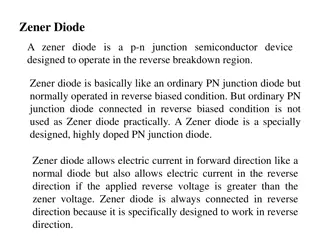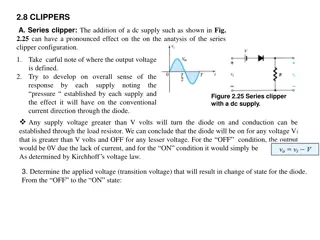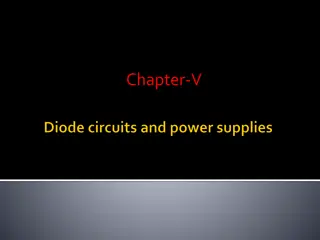Understanding Tunnel Diode: A High-Speed Solid-State Electronic Device
Tunnel diode, a heavily doped solid-state electronic device, displays negative resistance due to the phenomenon of Tunneling. It is utilized as a fast-switching component in computers, with germanium being a common material used to manufacture it. The depletion region's width in a tunnel diode is extremely narrow, enabling current flow with minimal applied voltage compared to regular p-n junction diodes. This characteristic is attributed to the high impurities concentration in the p-type and n-type semiconductors, creating a unique electrical behavior essential for efficient electronic applications.
Download Presentation

Please find below an Image/Link to download the presentation.
The content on the website is provided AS IS for your information and personal use only. It may not be sold, licensed, or shared on other websites without obtaining consent from the author. Download presentation by click this link. If you encounter any issues during the download, it is possible that the publisher has removed the file from their server.
E N D
Presentation Transcript
Tunnel diode Tunnel diode is one of the most significant solid-state electronic devices which is heavily doped with impurities, it exhibits negative resistance which means the electric current across the tunnel diode decreases when the voltage increases. The tunnel diode is used as a very fast switching device in computers. The operation of tunnel diode depends on a principle known as Tunneling. In electronics, tunneling means a direct flow of electrons across the small depletion region from n-side conduction band into the p-side valence band. The germanium material is commonly used to make the tunnel diodes. They are also made from other types of materials such as gallium arsenide, gallium antimonide, and silicon.
Symbol of tunnel diode The symbol of tunnel diode is shown in the figure. Anode is a positively charged electrode which attracts electrons whereas cathode is a negatively charged electrode which emits electrons. In tunnel diode, n-type semiconductor emits or produces electrons so it is referred to as the cathode. On the other hand, p-type semiconductor attracts electrons emitted from the n-type semiconductor so p-type semiconductor is referred to as the anode.
Width of the depletion region in tunnel diode The depletion region is a region in a p-n junction diode where mobile charge carriers (free electrons and holes) are absent. It is made up of positive and negative ions. Because of these ions, there exists a built-in-potential or electric field which opposes the flow of electrons from the n-type semiconductor and holes from the p-type semiconductor.
The width of a depletion region depends on the impurities concentration (Impurities are the atoms introduced into the p-type and n-type semiconductor to increase electrical conductivity). If a small number of impurities are added to the p-n junction diode, a wide depletion region is formed. On the other hand, if large numbers of impurities are added to the p-n junction diode, a narrow depletion region is formed. In tunnel diode, the p-type and n-type semiconductor is heavily doped which means a large number of impurities are introduced into the p-type and n-type semiconductor. This heavy doping process produces an extremely narrow depletion region. The concentration of impurities in tunnel diode is 1000 times greater than the normal p-n junction diode. In normal p-n junction diode, the depletion width is large as compared to the tunnel diode. This wide depletion layer opposes the flow of current. To overcome this barrier, we need to apply sufficient voltage. When sufficient voltage is applied electric current starts flowing through the normal p-n junction diode. Unlike the normal p-n junction diode, the width of a depletion layer in tunnel diode is extremely narrow. So applying a small voltage is enough to produce electric current in tunnel diode.
Electric current in ordinary p-n junction diode When a forward bias voltage is applied to the ordinary p-n junction diode, the width of depletion region decreases and at the same time the barrier height also decreases. However, the electrons in the n-type semiconductor cannot penetrate through the depletion layer because the built-in voltage of depletion layer opposes the flow of electrons. If the applied voltage is greater than the built-in voltage of depletion layer, the electrons from n-side overcomes the opposing force from depletion layer and then enters into p-side. In simple words, the electrons can pass over the barrier (depletion layer) if the energy of the electrons is greater than the barrier height or barrier potential.
Therefore, an ordinary p-n junction diode produces electric current only if the applied voltage is greater than the built-in voltage of the depletion region.
Electric current in tunnel diode In diode, the valence band and conduction band energy levels in the n-type semiconductor are lower than the valence band and conduction band energy levels in the p- type semiconductor. This difference in energy levels is due to the differences in the energy levels of the dopant atoms (donor or acceptor atoms) used to form the n-type and p- type semiconductor. Unlike the ordinary p-n junction diode, the difference in energy levels is very high in tunnel diode. Because of this high difference in energy levels, the conduction band of the n-type material overlaps with the valence band of the p-type material. The depletion layer of tunnel diode is very small (It is in nanometers). So the electrons can directly tunnel across the small depletion region from n-side conduction band into the p-side valence band.
In ordinary diodes, current is produced when the applied voltage is greater than the built-in voltage of the depletion region. But in tunnel diodes, a small voltage which is less than the built-in voltage of depletion region is enough to produce electric current. So, the electrons need not overcome the opposing force from the depletion layer to produce electric current. The electrons can directly tunnel from the conduction band of n-region into the valence band of p-region. Thus, electric current is produced in tunnel diode.
Step 1: Unbiased tunnel diode When no voltage is applied to the tunnel diode, it is said to be an unbiased tunnel diode. In tunnel diode, the conduction band of the n-type material overlaps with the valence band of the p-type material because of the heavy doping. Because of this overlapping, the conduction band electrons at n-side and valence band holes at p-side are nearly at the same energy level. So, when the temperature increases, some electrons tunnel from the conduction band of n-region to the valence band of p-region. In a similar way, holes tunnel from the valence band of p-region to the conduction band of n-region. However, the net current flow will be zero because an equal number of charge carriers (free electrons and holes) flow in opposite directions.
Step 2: Small voltage applied to the tunnel diode When a small voltage is applied to the tunnel diode which is less than the built-in voltage of the depletion layer, no forward current flows through the junction. However, a small number of electrons in the conduction band of the n-region will tunnel to the empty states of the valence band in p-region. This will create a small forward bias tunnel current. Thus, tunnel current starts flowing with a small application of voltage.
Step 3: Applied voltage is slightly increased When the voltage applied to the tunnel diode is slightly increased, a large number of free electrons at n-side and holes at p-side are generated. Because of the increase in voltage, the overlapping of the conduction band and valence band is increased. In simple words, the energy level of an n-side conduction band becomes exactly equal to the energy level of a p-side valence band. As a result, maximum tunnel current flows.
Step 4: Applied voltage is further increased If the applied voltage is further increased, a slight misalign of the conduction band and valence band takes place. Since the conduction band of the n-type material and the valence band of the p-type material sill overlap. The electrons tunnel from the conduction band of n-region to the valence band of p-region and cause a small current flow. Thus, the tunneling current starts decreasing.
Step 5: Applied voltage is largely increased If the applied voltage is largely increased, the tunneling current drops to zero. At this point, the conduction band and valence band no longer overlap and the tunnel diode operates in the same manner as a normal p-n junction diode. If this applied voltage is greater than the built-in potential of the depletion layer, the regular forward current starts flowing through the tunnel diode. The portion of the curve in which current decreases as the voltage increases is the negative resistance region of the tunnel diode. The negative resistance region is the most important and most widely used characteristic of the tunnel diode. A tunnel diode operating in the negative resistance region can be used as an amplifier or an oscillator.
Advantages of tunnel diodes Disadvantages of tunnel diodes Applications of tunnel diodes used as logic memory storage devices. Long life Being a two terminal device, the input and output are not isolated from one another. High-speed operation used in relaxation oscillator circuits. Low noise used as an ultra high-speed switch. Low power consumption used in FM receivers.























